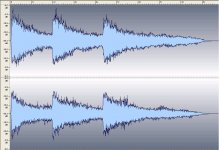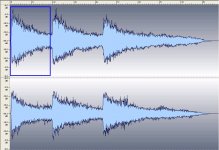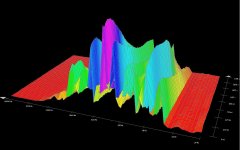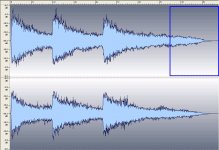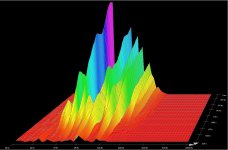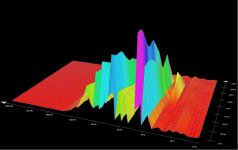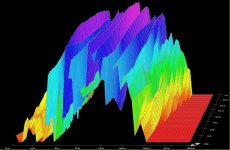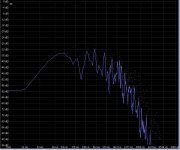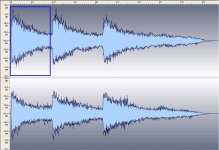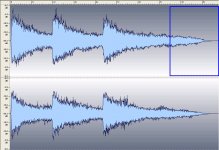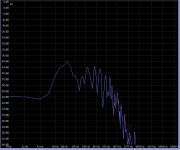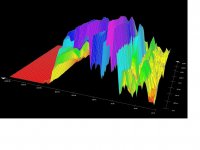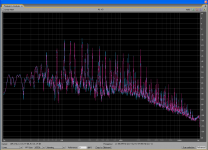What I love about that analysis is that it does a fingers sign at those who froth at the mouth about below 100Hz capabilities being essential for making 'proper' reproduction work - the real bass stuff, below 100Hz, is a very minor player in the overall sound - so a miserable 3" full range speaker, that does everything above 100Hz excellently, will be remarkably realistic ...
In any case, the harmonics are stronger than the fundamental.
This is quite usual, even with guitar low strings.
The question may be asked what miking was used.
Mooly’s music file is a three consecutive key strokes, one blending into the other.
A frequency spectrum of the whole file does not provide any clear information.
When studying the sound of music instruments, the element of time is very important. Visualizing the different build-up and decay rates of the various partials, helps in understanding the meaning of timbre.
George
A frequency spectrum of the whole file does not provide any clear information.
When studying the sound of music instruments, the element of time is very important. Visualizing the different build-up and decay rates of the various partials, helps in understanding the meaning of timbre.
George
Attachments
Here is what happens during the last 2.7s of the third key stroke
George
>Edit: the vertical scale (amplitude) is linear and auto-normalizes to the strongest partial of the tone
George
>Edit: the vertical scale (amplitude) is linear and auto-normalizes to the strongest partial of the tone
Attachments
Last edited:
According to Wikipedia the lowest D may be at 36.7Hz. PMAs first spectrum shows a strong peak at this frequency, but his second does not.
We just need to know what key was hit, I might go play with our Steinway.
We perceive sound intensity in a logarithmic fashion, so I show the same plots with a logarithmic vertical axis (amplitude) .
I enclose also an FFT screenshot of the same musical part.
George
I enclose also an FFT screenshot of the same musical part.
George
Attachments
We just need to know what key was hit, I might go play with our Steinway.
Mooly said it is the bottom D.
Waterfall plots show it is the D2 key (nominal 73.416Hz).
I can hear it as such too.
The pianist hits the key hard. This excites the higher odd harmonics of the operated string a lot (the other strings are resonating as well)
He may also perform a double key strike (D2 and D3)
George
Last edited:
The 20+ digits of resolution is required? 🙂
> The 20+ digits of resolution is required?
Because the ratios are burdened by the ' tempered '
(logrythmic) scale ......
HOWEVER .....
Even using ' just ' intonation
8 bits is needed for 1 octave of a Pythagoren scale
Because the ratios are burdened by the ' tempered '
(logrythmic) scale ......
HOWEVER .....
Even using ' just ' intonation
8 bits is needed for 1 octave of a Pythagoren scale
So I opened the window (no screen) on the field/woods side of the house and sat about 8 feet back, and fired a .308, from inside the house.
Holy mother of god that's loud.
Teh interwebs sez:
Rifles ........................... 156-167 dB Peak.
Ouch.
😀 when I read this sentence, it stopped me - I thought to myself -- INDOORS! that's going to be a really loud bang! Are you crAAAzy! 'Cause its loud outside too with your ears just arms length away. Good thing it wasn't a .223 (AR15/M16) with its 2 foot wide flame at the muzzle exit tapering to a point three feet in front of the barrel end (at night this is spectacular). Man its loud... every infantry person is deaf. In the movies they shoot indoors all the time and often several at once going off. often next to another persons head/ear.
JBL and 100K worth system does a audio/video demo using gun shots for the realism factor and to wow the spectator with the realism their best pro compression drivers can impart....used old black and white film of a western movie shooting percussion pistol sounds originally recorded on film strip of the era. pretty sad. What were/are they thinking? No one's heard a real weapon fired?
Oh xcuse me....
-RNM
Last edited:
Richard,
That is what they make sound barriers for! Seems like the fastest way to loose your hearing.
That is what they make sound barriers for! Seems like the fastest way to loose your hearing.
Quite some years ago the local cinema had a full makeover of its audio speakers by the passionate local hifi guru, had the full DTS thing done, and while still spanking new they showed "Saving Private Ryan". The big intro, the gun shots were right on the money; the raw, visceral, crack, cutting through your skull impact of the real thing was there, in the theatre for the ten minutes or so - I was mentally exhausted by the end of it ... 🙂
What I love about that analysis is that it does a fingers sign at those who froth at the mouth about below 100Hz capabilities being essential for making 'proper' reproduction work - the real bass stuff, below 100Hz, is a very minor player in the overall sound - so a miserable 3" full range speaker, that does everything above 100Hz excellently, will be remarkably realistic ...
Lol, hilarious stuff frank .....🙄 You need gigantum speakers to come anywhere near the realism of a grand piano ..
Last edited:
Master a.wayne, I think we've been here before, a few times, in fact ... 😉
One only needs 'ginormous' speakers to get certain types of bass drivers and configurations to function in the lower octaves correctly - otherwise a miniscule enclosure will be sufficient, provided it is relatively inert, and locked solidly to a relatively heavy structure - and, the driver(s) mounted on it are capable of the volumes, and they're being driven by clean electronics.
One only needs 'ginormous' speakers to get certain types of bass drivers and configurations to function in the lower octaves correctly - otherwise a miniscule enclosure will be sufficient, provided it is relatively inert, and locked solidly to a relatively heavy structure - and, the driver(s) mounted on it are capable of the volumes, and they're being driven by clean electronics.
I hope you do not mind me posting analysis of your file 😉
Not at all. You guys are way ahead of me on using software to analyse these things.
Is low D ~73Hz on a piano?
An octave lower, 36.7Hz
- Status
- Not open for further replies.
- Home
- Member Areas
- The Lounge
- John Curl's Blowtorch preamplifier part II
